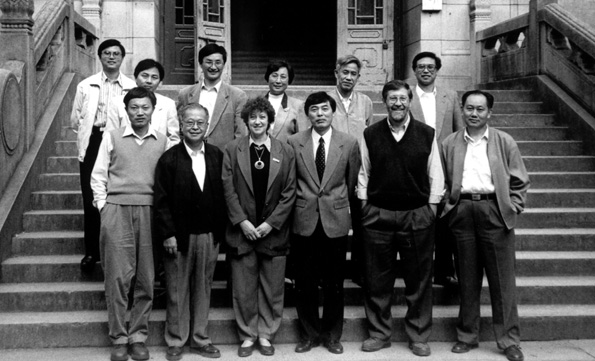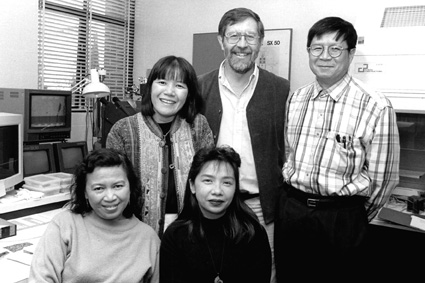GEMOC's international links
- GEMOC has strong international links particularly with Asia (including China, Japan, Mongolia, Myanmar and Thailand) and the former USSR
- targeted Asian regions have geological similarities and contrasts that help us to interpret the geological structure and metallogenic framework of the Australian continent: they provide more easily studied analogues to some of the tectonic terranes
- models for continental breakup and reassembly show that during at least two major times of continental rearrangement, parts of the Australian continent split off and ultimately docked to form parts of east Asia
- detailed investigations of terrane boundaries in Asia and eastern Australia should be able to shed more light on this aspect of great significance to the location of some economic deposits

The sweep of the China/Mongolia/Siberia lithosphere traverse |
examples of active funded projects in
Asia
|
funded collaborative projects initiated 1998 include:
- Collaborative project negotiated with the Regional Gravity Centre, Xi'an to model lithosphere structure along China Geotraverse sections. This has been formally endorsed by the Academy of Geoexploration.
- Professors O'Reilly and Griffin, with Dr Sun Lin Chung from Taiwan University, were co-convenors of a session at the American Geophysical Union (AGU) International Meeting in Taiwan in July, 1998 dedicated to the nature of the lithosphere in eastern China and adjacent regions.
- Fieldwork was carried out in the Penghu Islands (Taiwan) as part of the project on the nature of the mantle in eastern China.
- GEMOC was invited to join the international project "Continental Growth in the Phanerozoic: Evidence from East-Central Asia" designated IGCP (International Geological Correlation Program) Project 420. O'Reilly, Griffin and Zhang attended the first workshop in Urumqi and a related fieldtrip to the Altai region.
- A formal Workshop was held in the Department of Earth Sciences, Nanjing University on 19th ?26th October, 1998 focussed on "Crust-mantle interaction in southeastern China"
- A new collaboration with the Northwestern University, Xi'an was initiated with Dr Lai Shaocong to visit Macquarie in 1999.
- Drs Pornsawat Wathanakul (Kasetsart University, Bangkok), Visut Pisutha-Arnond (Chalalongkorn University, Bangkok) and Dr Suporn Intasopa (Department of Mineral Resources, Bangkok) visited GEMOC to undertake a new collaborative project on the genesis of corundum (in Thailand).
- A formal agreement to continue and enhance collaboration between Macquarie University and the University of Jean-Monnet, St Etienne, was made at the Kerguelen Workshop in St Etienne in September 1998. This includes PhD exchange, academic exchange and research collaboration relevant to the nature of the lithosphere in the Kerguelen Archipelago, Crozet Islands, Hoggar and the Massif Central.
- In collaboration with Drs H. Laperre and E. Jaillard of the Institut Dolomieu of the Universite Joseph Fourier and CNRS (Grenoble) respectively, Richard Arculus has been involved in studies of the Andean margin of Ecuador
 Some of the Nanjing and Macquarie collaborators in the ACILP
project at the Nanjing Workshop in October 1998. The vice-President
of Nanjing University is third from the right in the front row.
Some of the Nanjing and Macquarie collaborators in the ACILP
project at the Nanjing Workshop in October 1998. The vice-President
of Nanjing University is third from the right in the front row.
funded collaborative projects ongoing in 1997 include:
- Igneous rocks, mineral deposits and tectonic setting: southeastern China and eastern Australia (with Nanjing University led in China by Prof. Zhou Xinmin with reciprocal funding from China sources). This is funded by AusAID under the ACILP scheme.
- Lithosphere Mapping in eastern China (with a Consortium of participating institutions in a 5-year National Priority Program funded by China NSF from 1997, led in China by Prof Zhou Xinhua of the Geological Institute, Academy of Sciences, Beijing). Results and material from GEMOC's previous International Links Project played a key role in the success of this project funding in China.
- Nature of Siberian Lithosphere part 2 (with WMC)
- Canadian shield lithosphere structure (with Kennecott Canada)
- Thermal and petrologic structure of the Rio Grande Rift and Baja California (with USA partners)
- Deccan plume mantle (with Pune University)
- Kerguelen Archipelago lithosphere structure (with the University of St Etienne)
- Inclusions in diamonds from Canadian lithosphere (with Kennecott Canada)
- Thailand diamonds, sapphires and basalts (with Kasetstart University, Myanmar Ministry of Mines and CSIRO)
- Refer to the Research Program and Postgraduate sections of this Report for details of other collaborative research projects and postgraduate exchanges.
GEMOC participants also have a wide range of other research collaborations
with colleagues in UK, USA, Europe (France, Germany, Norway) as described
in the section on Research Programs and in Appendix 5.

The Thai team at Macquarie in 1998:Left to right: Ms Tin Tin Win, Dr Pornsawat Wathanakul, Dr Suporn Intasopa, Professor William Griffin and Dr Visut Pisutha-Arnond.

 GEMOC ARC National Key Centre
GEMOC ARC National Key Centre